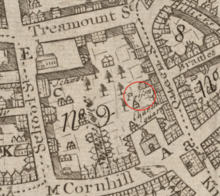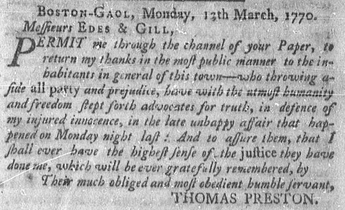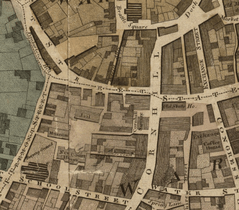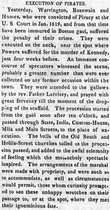Boston Gaol (Massachusetts)
The Boston Gaol (1635–1822) was a jail in the center of Boston, Massachusetts, located off Court Street, in the block bounded by School, Washington and Tremont Streets.[1] It was rebuilt several times on the same site, before finally moving to the West End in 1822. Prisoners included Quakers, "witches," pirates, murderers, rebels, debtors, and newspaper editors.

History
"Opened in 1635, the Boston Gaol served as Massachusetts' sole prison for eighteen years. ... As settlers fanned out into the wilderness, organizing new townships as they went, local facilities for incarceration sprang up elsewhere."[2] The Boston jail sat on Prison Lane (1634–1708), which became later known as Queen Street (1708–1788), and then Court Street (from 1788).[3] Around 1689, "the old stone gaol on Prison Lane [had] ... outer walls ... of stone three feet thick, its unglazed windows barred with iron, 'the cells partitioned off with plank, the doors covered with iron spikes, the passage-ways like the dark valley of the shadow of death.'"[4] In 1704, a new building replaced the old on the same site.[5]
"The prison and its dungeon were considerably repaired after the great fire of 1711, in that neighborhood, which destroyed the town house and first church. The keeper's house was also renovated."[6] "The keys of the building were twelve to eighteen inches long and were expressive of the formidable character of the jail, the walls of which were three feet thick."[7] "There is no reason to suppose that Boston Jail was any worse than most other prisons of that period. But that it was a forbidding place is amply attested by Daniel Fowle, the Boston printer, in his "Total Eclipse of Liberty:" ... 'If there is any such thing as a hell upon earth, I think this place is the nearest resemblance of any I can conceive of.'"[6] "A new building designed by Governor Bernard replaced [the old] in 1767."[6]
"The Massachusetts Charitable Society, at their quarterly meeting last Monday evening [in December 1797], unanimously voted a blanket for each prisoner now confined in Boston gaol, and as much fuel as will be necessary to keep them comfortable during the inclemency of the season."[8] In 1805 "the sons of misfortune and penury, the debtors, now in Boston gaol, partook of the joys of Independence, on the 4th inst. The liberality of several gentlemen afforded them a handsome repast; and a number of appropriate toasts were given on the occasion."[9]
By 1807 the "county gaol" appeared as "a plain stone building of considerable strength," located "in the rear of the court-house."[10] "The jail [was] a three story building with corridors on the outside of the upper stories, in which were the prisoners confined for debt."[11] In December 1819, there were "now confined in this gaol, poor debtors and poor criminals, as follows: 95 men, 29 women - total 124. Of whom are destitute of clothing 19 men and 20 women."[12] Through the years, gaol keepers included Mr. Salter (c. 1662); Richard Brackett (c. 1665);[13] Seth Smith (c. 1711);[6] William Young (c. 1740);[14] Oliver Hartshorn (c. 1796).[15]
The Leverett-street jail opened in 1822, replacing the old prison off Court Street. "In 1823 the old gaol was taken down, and its materials were partly used in constructing the gun house and ward room on Thacher Street" in the North End.[16]
Inmates
|
|
|
See also
- Leverett Street Jail (1822–1851)
Images
 Newspaper item from prisoner Thomas Preston, 1770
Newspaper item from prisoner Thomas Preston, 1770 John Stewart confession, 1797 (Library of Congress)
John Stewart confession, 1797 (Library of Congress) Boston Gaol, 1799
Boston Gaol, 1799 Detail of 1814 map of Boston, showing "jail." Nearby was the Columbian Museum
Detail of 1814 map of Boston, showing "jail." Nearby was the Columbian Museum Description of procession of pirates from jail to place of execution, 1820
Description of procession of pirates from jail to place of execution, 1820
References
- ↑ Edward H. Savage (1884), Boston events. A brief mention and the date of more than 5,000 events that transpired in Boston from 1620 to 1880, covering a period of 250 years, together with other occurrences of interest, arranged in alphabetical order, Boston: Tolman & White, printers
- ↑ Adam J. Hirsch. From Pillory to Penitentiary: The Rise of Criminal Incarceration in Early Massachusetts. Michigan Law Review, Vol. 80, No. 6 (May, 1982)
- ↑ Boston (Mass.). Street laying-out Dept. (1910), A record of the streets, alleys, places, etc. in the city of Boston (2 ed.), Boston: City of Boston Printing Dept.
- ↑ Foote. Annals of King's Chapel from the Puritan age of New England to the present day, Volume 1. Boston: Little, Brown, 1900; p.86
- ↑ Jim Vrabel (2004), When in Boston: a time line & almanac, Boston: Northeastern University Press, ISBN 1555536212, 1555536212
- 1 2 3 4 5 6 Bulletin of the Public Library of the City of Boston. March 1919.
- ↑ "These keys are now in the collections of the Bostonian Society, Old State House." cf. Bulletin of the Public Library of the City of Boston. March 1919; p.82
- ↑ State Gazette of South-Carolina; Date: 12-29-1792
- ↑ Massachusetts. Boston, July 6. National Birth Day. Courier of New Hampshire; Date: 07-17-1805
- ↑ Boston Directory. 1807
- ↑ Watkins (1905). "Boston one hundred years ago". Proceedings of the Bostonian Society.
- ↑ Neh. Freeman. Boston Gaol, Dec. 11, 1819. Boston Daily Advertiser; Date: 12-18-1819
- ↑ Savage. 1884
- 1 2 Goold (1875). "Early papermills of New-England". New England Historical and Genealogical Register. 29.
- ↑ Boston Directory. 1796
- ↑ Caleb H. Snow (1828), A history of Boston (2 ed.), Boston: A. Bowen, OCLC 734614
- 1 2 3 4 Justin Winsor (1881), The memorial history of Boston, Boston: Osgood
- ↑ James K. Wellman. Belief and bloodshed: religion and violence across time and tradition. Rowman & Littlefield, 2007; p.100+
- ↑ James Bowden. History of the Society of Friends in America. London: Gilpin, 1850
- ↑ Barber, Samuel (1916), Boston Common: a diary of notable events, incidents, and neighboring occurrences (2 ed.), Boston: Christopher Publishing House, OCLC 5782282
- ↑ Frank E. Moynahan. Danvers, Massachusetts: a resume of her past history and progress, together with a condensed summary of her industrial advantages and development : biographies of prominent Danvers men and a series of comprehensive sketches of her representative manufacturing and commercial enterprises. Published in the interest of the town by the Danvers Mirror, 1899; p.96
- ↑ Essex Institute Historical Collections, Volume 42. 1906. p. 141. Retrieved July 30, 2015.
- ↑ "Silence Dogood: Benjamin Franklin in The New-England Courant". Massachusetts Historical Society. Archived from the original on June 2010.
- ↑ Isaiah Thomas (1810), The history of printing in America, Worcester: From the press of Isaiah Thomas, Jun.
- ↑ Louise Phelps Kellogg (1918). "The Paul Revere Print of the Boston Massacre". Wisconsin Magazine of History. 1 (4).
- ↑ Columbian Gazetteer (NY); Date: 01-16-1794
- ↑ Loudon's New-York Packet; Date: 12-22-1786
- ↑ Farmers' Cabinet (New Hampshire); Date: 11-18-1806
- ↑ Common Gaol, Boston, Jan. 15, 1812. Boston Patriot; Date: 01-25-1812
- ↑ Brigham, Clarence S. "Bibliography of American newspapers, 1690-1820: part 3: Maryland to Massachusetts (Boston)". Proceedings of the American Antiquarian Society. 25(1): 128-293. 1915. Retrieved 30 August 2010.
- ↑ American Broadsides and Ephemera, Series 1
- ↑ Execution of Pirates. New-England Galaxy & Masonic Magazine; Date: 06-16-1820
- ↑ New-Hampshire Patriot & State Gazette; Date: 07-29-1822
Further reading
| Wikimedia Commons has media related to Boston gaol. |
- Daniel Fowle (1755), A total eclipse of liberty: Being a true and faithful account of the arraignment, and examination of Daniel Fowle before the Honourable House of Representatives of the province of the Massachusetts-Bay in New-England, Octob. 24th 1754. barely on suspicion of his being concern'd in printing and publishing a pamphlet, intitled, the Monster of Monsters. Also his imprisonment and sufferings in a stinking stone goal [sic], without the liberty of pen, ink or paper, and not allowed to see his nearest friends, nor to write a line to his wife; with many other incidents and aggravations; which shews it to be monstrous treatment, Boston: D. Fowle
- "The confession, last words, and dying speech of John Stewart, a native of Ireland. Taken from himself, at his own particular request ... (Signed) John Stewart. Boston jail, April 6, 1797". Library of Congress, Rare Book and Special Collections Division. 1797.
- Suffolk County Gaol. New-England Galaxy & Masonic Magazine; 06-18-1819.
- Samuel Gardner Drake (1856), The history and antiquities of Boston, Boston: Luther Stevens p. 635.
- "Petition of poor prisoners in Boston Jail, 1713". Bulletin of the Public Library of the City of Boston. 1919.
Coordinates: 42°21′31.96″N 71°3′29.2″W / 42.3588778°N 71.058111°W